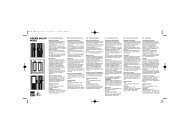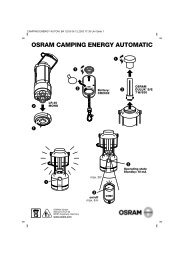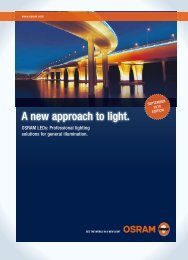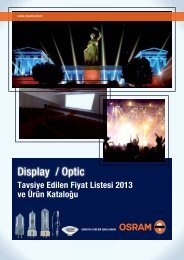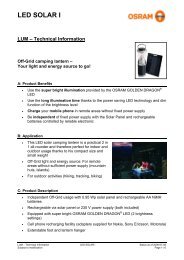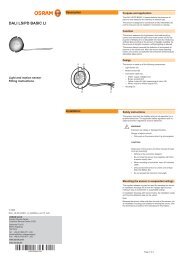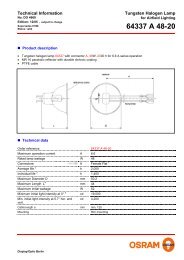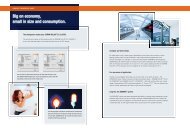Create successful ePaper yourself
Turn your PDF publications into a flip-book with our unique Google optimized e-Paper software.
U<br />
[V]<br />
230V· 2<br />
U1N<br />
U2N<br />
U3N<br />
250<br />
0<br />
-250<br />
Line voltages in excess of<br />
264 V either occur briefly in<br />
the form of "voltage peaks",<br />
or they are permanently<br />
present as a result of faulty<br />
installation in the three-phase<br />
system.<br />
With <strong>ECG</strong> from the Professional<br />
segment, the input voltage<br />
can even assume values of up<br />
to 350 V for a defined period<br />
of time. This has no effect on<br />
the operation of the <strong>ECG</strong>.<br />
In most cases, faulty installation<br />
involves the neutral conductor<br />
not being connected. This can,<br />
for example, happen following<br />
official acceptance of a largescale<br />
installation by a test<br />
institute, since the neutral<br />
conductor has to be disconnected<br />
for some tests.<br />
Depending on where the<br />
neutral point is displaced to<br />
(Fig. 2), the applied input voltage<br />
can also drop to below<br />
200 V. QUICKTRONIC <strong>ECG</strong><br />
from the Professional segment<br />
is likewise designed to cope<br />
with this phenomenon.<br />
However, regardless of the<br />
<strong>ECG</strong> used, a fluorescent lamp<br />
can only be ignited at above<br />
198 V. In other words, reliable<br />
"switching on" of the lighting<br />
cannot be guaranteed below<br />
this voltage value.<br />
Experience acquired by<br />
OSRAM in recent years has<br />
shown that these product<br />
characteristics of QUICK-<br />
TRONIC control gear from the<br />
Professional segment are<br />
perfectly adequate (Table 1)<br />
for preventing the <strong>ECG</strong> from<br />
being damaged by overvoltage<br />
or undervoltage.<br />
U<br />
[V]<br />
230V· 2<br />
250<br />
Without neutral<br />
With neutral<br />
point displacement<br />
point displacement<br />
10 20 t [ms]<br />
Fig. 3. Oscillogram of the phase voltages without and with neutral point displacement<br />
U1N<br />
U2N<br />
U3N<br />
0<br />
-250<br />
OSRAM <strong>ECG</strong> from the<br />
Professional segment is<br />
equipped for all phenomena<br />
in the network and requires<br />
no additional audible or visual<br />
signals, which put an additional<br />
burden on the electronics<br />
as a result of rapidly alternating<br />
high voltages and 0 V on<br />
the components.<br />
Cornelia Fürst and<br />
Markus Heckmann,<br />
OSRAM Munich<br />
Characteristics of QUICKTRONIC <strong>ECG</strong> from the<br />
Professional segment:<br />
• Input voltage 220 V to 240 V<br />
• AC voltage from 198 V to 264 V for reliable lamp ignition<br />
• No damage in case of a permanent input voltage of up to 320 V<br />
• Short-term input voltages of 350 V (up to 2 hours) do not<br />
damage this <strong>ECG</strong><br />
10 20 t [ms]<br />
T5 FQ T5 FH T8 Compact<br />
fluorescent lamps fluorescent lamps fluorescent lamps fluorescent lamps<br />
QTi DALI 1x/2x… DIM* QTi DALI 1x/2x… DIM* QTi DALI 1x/2x… DIM*<br />
QT DALI-FQ 1x/2x... QT DALI-FH 1x/2x/3x/4x… QT DALI-L 1x/2x/3x/4x... QT DALI-T/E 1x/2x…<br />
QTi 1x/2x… DIM* QTi 1x/2x… DIM* QTi 1x/2x… DIM*<br />
QT-FQ 1x/2x… DIM QT-FH 1x/2x/3x/4x… DIM HF 1x/2x/3x/4x… DIM QT-T/E 1x/2x… DIM<br />
QTi 1x/2x…* QTi 1x/2x…* QTi 1x/2x…*<br />
QT-FQ 1x/2x… QT-FH MULTIWATT 1x/2x... QTP 1x/2x/3x/4x… QTM 1x/2x...<br />
QT-FQ 1x/2x… F/CW QT-FH MULTIWATT 1x/2x...<br />
F/CW<br />
QT-FH 3x/4x14<br />
* Additional product characteristics can be found at www.osram.com/products/electronical/quicktronic/qti<br />
Table 1. QUICKTRONIC control gear from the Professional segment<br />
OSRAM <strong>ECG</strong>-<strong>SPOT</strong> 2/<strong>2004</strong><br />
9




